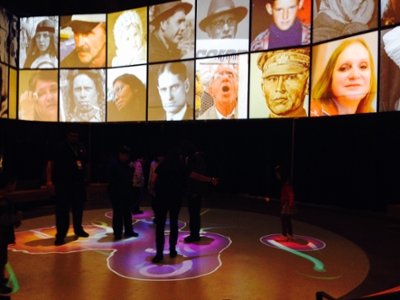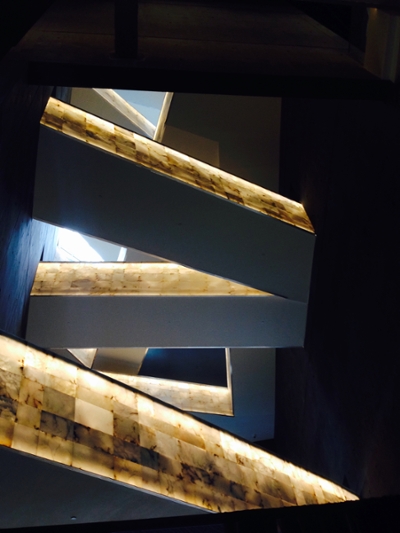Museum Openings
Sun. Oct. 5, 2014

by Angela Failler and Erica Lehrer
Canada’s newest national museum recently opened its doors to the public. Much was made of its monumental architecture and eye-catching digital exhibits. But beyond spectacular surface effects, what might we expect from the museum, and what should the museum expect from us?
“For the cost of a night at the movies or pizza for the family, visitors can experience a journey of inspiration unlike anything they’ve seen before,” the Canadian Museum for Human Rights (CMHR) announced in the months leading up to its inauguration. This rhetoric of museum-as-entertainment prepares us to take in human rights as we would a show. Elsewhere the museum promises to support “dynamic discussion” and “empower people to change thought and action,” to be a site of active ‘doing’ rather than passive viewing. With only a few, unfinished spaces thus far open to the public, it is hard to know which version the museum will ultimately commit to.
As scholars investigating the ways museums care for “difficult knowledge” -- a term coined by education theorists Deborah Britzman and Alice Pitt to describe the challenges inherent in learning from accounts of human suffering -- we look on the CMHR with both hope and trepidation. The museum offers an unprecedented opportunity to spark important discussions about how local and national communities might address legacies of violence and oppression, and celebrate achievements of social justice. And yet both mainstream commentary and the CMHR’s own promotional messaging reveals a narrow sense of what a museum is for and what it can do.

The reactions of local indigenous activists to the museum suggest an expanded view of the museum and its potentialities. In response to the CMHR’s showcasing of the building’s reflection pools as a “symbol of healing,” one group, the people of Shoal Lake 40 First Nation, opened their own community as a “living museum” they’ve called the Museum of Canadian Human Rights Violations. Their goal is to draw attention to the exploitation of their local resources by Manitoba’s hydroelectric system, at the cost of potable water for their own community.
It is up to all of us to approach the CMHR this way – as a catalyst to renewed engagement with the world around us, and a forum for taking action on injustices in our midst. Members of our various communities bring with them a range of experiences including deep and intimate knowledge of painful histories that may (or may not) be on display at the CMHR. We must see ourselves, and be seen by the museum, as essential partners in contributing to and challenging its representations of human rights. It is in this spirit that we call on the public to help the museum rise to its higher mandate.
We also hope for courageous curating by the museum itself. Curators can help move us away from viewing episodes of historical violence as discrete units for comparison, considering instead how ideologies that lead to human rights violations may be interrelated and ongoing. Such an approach opens the way for a broader sense of shared fate and responsibility across community groups, rather than the deadlock of competition among them. We look to the museum’s curators for tools to understand not only the history and politics behind the perpetration of the Holocaust, Holodomor, or the systematic violence done to First Nations, Inuit, and Métis people in Canada, but also the process of publicly naming and claiming these and other instances of persecution.

Curators would do well to “turn the museum inside out,” so to speak, by showing us the behind-the-scenes disputes over exhibition content and design that the museum’s PR channels typically work to smooth over. What would it look like, in other words, for the CMHR to put its own difficult knowledge on display? Such transparency would not only help us better appreciate the challenges faced by a museum staff tasked with representing human rights, it would also make good on the museum’s stated commitment to meaningfully involve the public in building a collective vision of a more just society. The CMHR is breaking new ground with the scope of human rights issues it plans to bring under one roof. It seems only fitting that they should also be a leader in curatorial practice. This includes ushering audiences towards new expectations of museums and new ways of museum-visiting -- modeling dissensus as a basis for learning how to better live with difference, and to see ourselves connected to the social realities of so-called “others.”
Such a shift in museum-being and museum-going means stepping outside of our comfort zones and re-thinking familiar perspectives. Sometimes it means facing up to our own implication in the misdeeds of the past and present. This is a risky endeavour for a national cultural institution under pressure to deliver a positive visitor experience and narratives of hope and pride. But if the CMHR is to offer real opportunities for visitors to engage in such learning, museumgoers themselves must demand more than entertainment. We must expect the museum to challenge us, and the museum must expect to be challenged in return.
Angela Failler is Chancellor's Research Chair with the University of Winnipeg, and Lead Researcher for the Cultural Studies Research Group (CSRG).
Erica Lehrer is Canada Research Chair in Post-Conflict Memory, Ethnography and Museology, and is the Director of Concordia University's Centre for Ethnographic Research and Exhibition in the Aftermath of Violence (CEREV).
photo credits: Angela Failler
